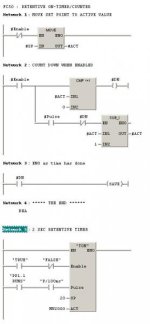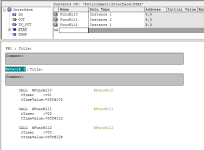minerman
Member
Can you give me a suggestion for using a retentive on-delay timer within a function block that will have multiple instances?
I have found two possible options but I am unsure how to implement either:
1. FC80 (under TI-S7 Converting Blocks). I am nervous that this will not work when its inside an FB that has multiple instances. I am also unsure of what to use for the DELTA_T input. The examples that I have seen, say to use #OB1_Prev_Cycle. I am not programming inside of OB1, so I don’t think the FB recognizes this.
2. S_ODTS (standard instruction set). I’m still unsure how to specify a memory location for any type of timer that will be reused in a function block with multiple instances. I know I can assign data T10 to the timer, but I don’t understand how this works with multiple instances. If I assign T10, what memory will be used for the 2nd instance of the function block?
Thanks!
I have found two possible options but I am unsure how to implement either:
1. FC80 (under TI-S7 Converting Blocks). I am nervous that this will not work when its inside an FB that has multiple instances. I am also unsure of what to use for the DELTA_T input. The examples that I have seen, say to use #OB1_Prev_Cycle. I am not programming inside of OB1, so I don’t think the FB recognizes this.
2. S_ODTS (standard instruction set). I’m still unsure how to specify a memory location for any type of timer that will be reused in a function block with multiple instances. I know I can assign data T10 to the timer, but I don’t understand how this works with multiple instances. If I assign T10, what memory will be used for the 2nd instance of the function block?
Thanks!









